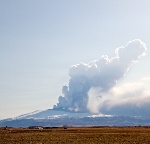Gaua Volcano
In early April 2010, activity at Gaua Volcano in the Vanuatu Archipelago increased. The Vanuatu Geohazards Observatory reported that the ash column, which first appeared in October 2009, became thicker and higher (compare this image to one from February 14th), and volcanic bombs were frequently sighted from the coastal villages surrounding the volcano. According to Radio New Zealand International, Vanuatu government officials are preparing to evacuate residents of Gaua Island, who are threatened by ash, poisonous gases, and landslides.
The thick, steam-rich plume from Guau Volcano blows directly northeast in this natural-color satellite image. It was acquired on April 24, 2010 by the Advanced Land Imager aboard NASA's Earth Observing-1 (EO-1) spacecraft. The thick steam is brighter white than the surrounding lower altitude clouds. Vegetation is green, as is Lake Letas. Vegetation to the south and west of the volcano, damaged by ash and acidic volcanic gases, is dark gray-brownImage here at source
Ischia volcano eruption concerns
The volcano of Ischia, a resort island famed for its thermal waters off the coast of Naples, could potentially erupt, Italian disaster experts said.
Guido Bertolaso, the head of Italy's civil protection agency, said that while Vesuvius was more commonly considered the nation's most worrisome volcano, Ischia, which last erupted 700 years ago, was experiencing a build-up of magma.
No eruption is imminent, but "if I had to say which is the volcano with the most loaded gun barrel, I'd say it's not Vesuvius but the island of Ischia", Mr Bertolaso said in Rome.
Ischia, a short hydrofoil trip from the port of Naples and the chic vacation island of Capri, is often overrun with Italian and foreign visitors seeking to ease their aches and pains in pools filled with thermal waters pumped in from the sea.
Ischia's "magma chamber is loading up", said Mr Bertolaso, whose agency's mandate includes both disaster relief and prevention. An eruption on Ischia "could be worse than a hypothetical Vesuvius eruption", he said.
While scientists detect no sign of an eruption, Ischia's volcanic potential is being monitored along with that of Vesuvius, the mountain that looms over Naples and destroyed Pompeii when it blew in 79 AD.
Vesuvius is a disaster planner's nightmare, since its slopes are officially inhabited by some 500,000 people, although perhaps as many as 150,000 more live in illegal, unregistered housing in the 18 hamlets clinging to its side, Mr Bertolaso said.
Considering that parts of crowded, chaotic Naples could be in the path of Vesuvius' fury, more than a million people might ultimately be ordered to evacuate in case of eruption, he estimated.
Seismologists have detected no signs of the quakes that are expected to rattle Vesuvius before any major eruption and could serve as a warning to evacuate, said Mr Bertolaso, whose agency includes vulcanologists as well as quake experts.
Italian volcano and earthquake experts are about to launch a several-year project to monitor and explore 13 largely unstudied undersea volcanoes in the Mediterranean, near Sicily and the southwest Italian coast, Mr Bertolaso announced.
The crater in the caldera of the volcano in Eyjafjallajökull glacier has grown. Coast Guard airplane TF-SIF flew over the eruption site yesterday.

The crater seen from air. Photo by Jóhannes Benediktsson.
The crew couldn't see the eruption but radar pictures show that the crater has expanded to 200 meters in diameter and has grown 150 meters tall, Morgunbladid reports.
The volcanic cloud was light in color, stretched to the east and three to five kilometers up from the crater. Ash fall was insignificant.
Rumbling could clearly be heard from the eruption site but no lighting has been seen in the volcanic cloud since April 19.
Lava is flowing underneath the glacier to the north of the crater and is melting the ice above and to the sides. There are no indications that the eruption is drawing to a close.
SourceIceland volcano facts and how it affects daily life
Posted on27 April 2010.

In Iceland, the 'First Day of Summer' was recently celebrated with numerous festivities taking place in downtown Reykjavik. This is yet another indication that day-to-day life continues as normal with the vast majority of the country and population being unaffected by the recent volcanic eruption.
The volcanic eruption at Eyjafjallajokull is currently around 1/10 of the size it was during the first few days and the ash clouds surrounding the volcano appear to be slowly decreasing. Those mainly affected are farmers in the immediate area located just to the south of the volcano crater. This is where the majority of volcanic ash has fallen and consequently acres of farmland and this year's crops have been damaged.
Last weekend, hundreds of volunteers travelled to the volcano area to assist with the cleaning up of volcanic ash and to help those affected by the eruption. The abundance of volunteers came together on Facebook with a group being made by numerous organisations such as the Icelandic Red Cross, the accident prevention association Ice-Sar and the jeep association 4×4. The federation of women's associations in Iceland also helped out by serving lunch at a local service centre for all the volunteers.
Source--
(Gars O'Higgins Station penguins)
http://wiinterrr.blogspot.com/
http://penguinnewstoday.blogspot.com/
http://penguinology.blogspot.com/
(Twilight Saga commentary)
http://throughgoldeneyes.blogspot.com/
(Coming soon---Volcano Watch!)
>^,,^<
__._,_.___
No comments:
Post a Comment